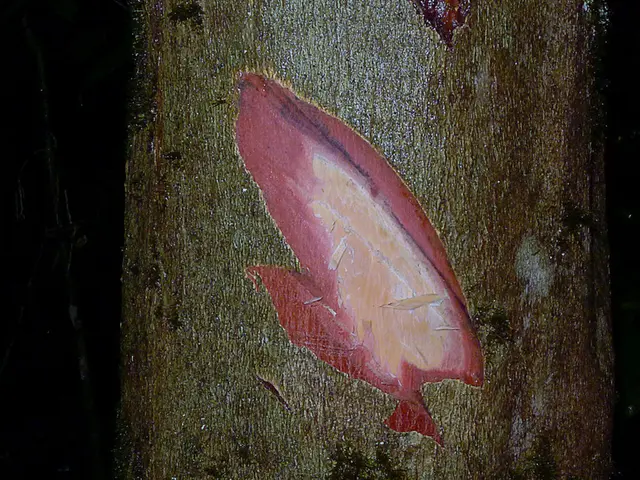Indoor Sunlight Still Wreaks Havoc on Skin Integrity
Get this, buddy! You think that you're safe after a long day in the sun, but It turns out, you're not. According to a groundbreaking study by Yale University, those UV rays don't just wreak havoc on your skin while you're baking beneath the sun - they continue to cause damage once you've retreated indoors.
Yep, you heard that right. Most of the damage linked to skin cancer actually happens after the sun has set. So even if you slather on that sunscreen faithfully and avoid getting sunburned, your skin cells might still be sustaining damage hours later, upping your risk of skin cancer.
But why, you ask? Well, it's all thanks to that pigment you thought kept you safe - melanin. While it's responsible for your skin, hair, and eye color and generally considered the skin's natural defense system, melanin can also trigger a chain reaction that causes DNA damage long after you've soaked up the rays.
Say what? Yep, that's right. Scientists used to think that melanin was all good and pure, but this new research hints that it's not just absorbing and scattering UV rays – it's setting off a chemical reaction called chemiexcitation. And guess what? This reaction continues to damage DNA, even in the dark.
So, let's get into the nitty-gritty details of what's going on beneath your skin and what you can do to protect yourself.
Protection and Destruction
Melanin is the pigment responsible for your skin, hair, and eye color. For a long time, it was seen as your skin's natural defense system, absorbing UV radiation and reducing its intensity. But a study published in Science has revealed that melanin can also contribute to DNA damage through chemiexcitation.
A Delayed Reaction
Researchers exposed mouse and human melanocyte cells (the cells responsible for producing melanin) to UV radiation. As expected, DNA mutations, the primary cause of skin cancer, were observed immediately after exposure. But here's where things took a surprising turn: damage to DNA continued to increase for more than three hours in the dark. That's right – the majority of genetic mutations were produced hours after UV exposure, not during.
So, what's happening inside your cells?
The Hidden Chemical Reaction That Mimics UV Damage
One of the researchers, Sanjay Premi, discovered that UV exposure activates two enzymes in the skin. These enzymes work together to excite an electron within the melanin molecule, which kicks off a chemical process called chemiexcitation. This reaction stores energy within the melanin molecule, similar to how certain bioluminescent plants and animals store energy to glow.
But here's the catch: hours later, this stored energy is released in a way that mimics the DNA damage caused by UV rays – but now, it's happening in total darkness.
"The unusual chemical properties of melanin that make it a good UV absorber also make it susceptible to other chemical reactions that just happen to have the same end result as UV exposure," explains lead researcher Douglas Brash. In other words, your skin continues "burning" from the inside, even after the sun has set.
"Once You're Out of the Sun, You're Safe"
Oh, if only that were true! For decades, sun protection advice has centered around avoiding direct sunlight and applying sunscreen before heading outdoors. But this study challenges a fundamental assumption: that UV damage only happens when you're still soaking up those rays.
You might think you're safe inside your home, but your skin could still be sustaining damage. You may believe that shade and sunscreen are enough, but neither can stop the internal reaction that occurs hours later. And hey, you may also assume that sunburn only matters during the day – but new research suggests that post-sun exposure care is just as critical.
This discovery changes the way we think about sun damage, skin cancer prevention, and even the effectiveness of our current sunscreens.
What Can You Do to Protect Your Skin?
The researchers behind this study are now focusing on developing new skincare treatments that could interrupt the delayed damage process before it occurs. But until these solutions are available, what steps can you take to protect yourself right now?
1. Sunscreen Is Still Crucial – But Maybe Not Alone
- Use a broad-spectrum sunscreen with SPF 30 or higher before heading outside.
- Reapply every two hours, especially if sweating or swimming.
- Look for sunscreens that contain DNA-repairing ingredients like niacinamide or antioxidants.
2. After-Sun Skincare Matters More Than You Think
- Consider using after-sun products with antioxidants like vitamin C and E to neutralize free radicals.
- Apply DNA-repairing serums at night to counteract ongoing damage.
- Look for ingredients like polyphenols and DNA enzymes, which may help prevent mutations.
3. Stay Vigilant with Skin Checks
- Given that UV damage continues for hours, monitor your skin for changes – especially if you've had prolonged sun exposure.
- Early detection of abnormal moles or lesions can significantly improve skin cancer outcomes.
4. Protective Clothing and Shade Are Still Important
- Wear hats, sunglasses, and UPF-rated clothing for an extra layer of protection.
- Seek shade between 10 AM and 4 PM, when UV rays are least damaging.
The future of sun protection is a race against time, but there are things you can do right now to protect yourself – and discussing this discovery with others can help raise awareness and inspire change. So let's talk: will this new finding change the way you protect your skin? Share your thoughts below!
Sources: Reuters via ABC Science, Science, Yale University
- In light of recent studies, it appears that health-and-wellness practices focused on skin care should extend beyond the use of sunscreen during sunny hours.
- The cleansing and nourishing aspects of health-and-wellness routines, such as after-sun products containing antioxidants, may play a significant role in counteracting delayed UV-induced damage caused to skin cells.







